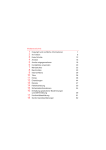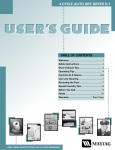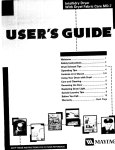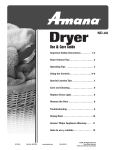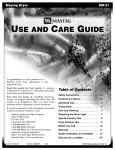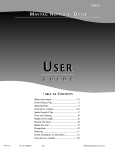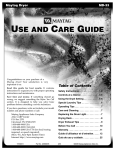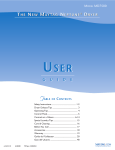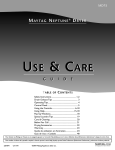Download Maytag MD6400 Use & care guide
Transcript
MD6400 ® Use & Care Guide Table of Contents Important Safety Instructions . . . . . . . . . . . . . .1-2 Special Laundry Tips . . . . . . . . . 7 Dryer Exhaust Tips . . . . . . . . . . . 8 Using the Controls . . . . . . . . . 3-4 Select Temperature Select Signal Select Cycle Pull the Control Dial out to Start Troubleshooting . . . . . . . . . . . . . . 9 Operating Tips . . . . . . . . . . . . . . . 5 Service Information . . . . . . . . . . 9 Clean the Lint Filter Load the Dryer Properly Drying Rack . . . . . . . . . . . . . . . 5-6 Care & Cleaning . . . . . . . . . . . . . 6 Control Panel Tumbler Cabinet Dryer Exhaust System Form No. Y82109 A Part No. 2207273 3/06 www.maytag.com Litho U.S.A. ©2006 Maytag Appliances Sales Co. Important Safety Instructions Installer: Please leave this guide with this appliance. Consumer: Please read and keep this guide for future reference. Keep sales receipt and/or canceled check as proof of purchase. Model Number _______________________________ Serial Number ________________________________ Date of Purchase ______________________________ Read this guide for best results. It contains instructions to acquaint you with proper operating instructions and maintenance. Save time and money. If something should go wrong, we suggest consulting the Before You Call section. It is designed to help you solve basic problems before consulting a service technician. In our continuing effort to improve the quality and performance of our appliances, it may be necessary to make changes to the appliance without revising this guide. For service information, see page 9. What You Need to Know About Safety Instructions Warning and Important Safety Instructions appearing in this guide are not meant to cover all possible conditions and situations that may occur. Common sense, caution and care must be exercised when installing, maintaining or operating appliance. Always contact your dealer, distributor, service agent or manufacturer about problems or conditions you do not understand. Recognize Safety Symbols, Words, Labels WARNING WARNING – Hazards or unsafe practices which COULD result in severe personal injury or death. CAUTION CAUTION – Hazards or unsafe practices which COULD result in minor personal injury. 1 WARNING For your safety, the information in this guide must be followed to minimize the risk of fire or explosion or to prevent property damage, personal injury or death. • Do not store or use petrol or other flammable vapours and liquids in the vicinity of this or any other appliance. Installation and service must be performed by a qualified installer or service agency. (see installation instructions). WARNING! FIRE HAZARD Do not place into your dryer items that have been spotted or soaked with vegetable oil or cooking oil. Even after being washed, these items may contain significant amounts of these oils. The remaining oil can ignite spontaneously. The potential for spontaneous ignition increases when the items containing vegetable oil or cooking oil are exposed to heat. Heat sources, such as your dryer, can warm these items, allowing an oxidation reaction in the oil to occur. Oxidation creates heat. If this heat cannot escape, the items can become hot enough to catch fire. Piling, stacking or storing these kinds of items may prevent heat from escaping and can create a fire hazard. All washed and unwashed fabrics that contain vegetable oil or cooking oil can be dangerous. Washing these items in hot water with extra detergent will reduce, but will not eliminate, the hazard. Always use the “cool down” cycle for these items to reduce the items’ temperature. Never remove these items from the dryer hot or interrupt the drying cycle until the items have run through the “cool down” cycle. Never pile or stack these items when they are hot. Important Safety Instructions WARNING To reduce the risk of fire, explosion, electric shock, or personal injury when using your dryer, follow basic safety precautions, including the following: 1. Read all instructions before using the appliance. As with any equipment using electricity and having moving parts, there are potential hazards. To use this appliance safely, the operator should become familiar with the instructions for operation of the appliance and always exercise care when using it. 2. To avoid the possibility of fire or explosion: a. Do not dry items that have been previously cleaned in, washed in, soaked in, or spotted with petrol, dry-cleaning solvents, other flammable or explosive substances as they give off vapours that could ignite or explode. Any material on which you have used a cleaning solvent, or which is saturated with flammable liquids or solids should not be placed in the appliance until all traces of these liquids or solids and their fumes have been removed. These substances include acetone, denatured alcohol, petrol, paraffin, kerosene, some liquid household cleaners, some spot removers, turpentine, waxes and wax removers. b. Items containing foam rubber (may be labeled latex foam) or similarly textured rubber-like materials must not be dried on a heat setting. Under certain circumstances foam rubber materials can produce fire by spontaneous combustion when heated. Rubber backed articles, clothes fitted with foam rubber pads, foam pillows, galoshes and rubber coated trainers should not be placed in the dryer. c. Do not dry items that are soiled with vegetable or cooking oil. These items may contain some oil after laundering. The remaining oil can ignite spontaneously. 3. Do not install or store this appliance where it will be exposed to the weather. 4. This appliance must be properly earthed. Never connect the appliance cord to a power supply that is not earthed adequately and in accordance with local and national codes. See installation instructions for earthing this appliance. 5. If the supply cord is damaged, it must be replaced with a specifically terminated cord from an authorized service agent or a similarly qualified person in order to avoid a hazard. 6. Young children should be supervised to ensure that they do not play on or in the appliance. Close supervision is necessary when the appliance is used near children. This appliance is not for use by young children or infirm persons without supervision. 7. Do not reach into the appliance if the drum is moving. 8. Do not tamper with controls. 9. Do not repair or replace any part of the appliance or attempt any servicing unless specifically recommended in published user-repair instructions that you understand and have the skills to carry out. Disconnect the appliance from the power supply when not in use, before cleaning or when carrying out any user maintenance task. 10. Plastic articles such as caps or babies’ waterproof napkin covers should not be dried with heat in the dryer. 11. Only use fabric softeners or other products to eliminate static that are specifically recommended by the manufacturer of the product for use in dryers. 12. Clean the lint screen before or after each load. 13. Keep the area around the exhaust opening and surrounding areas free from lint accumulation, dust and dirt. 14. The interior of the dryer and exhaust duct should be cleaned periodically by qualified service personnel. 15. Do not sit or stand on top of the appliance. 16. Do not continue to use this appliance if it appears faulty. 17 . Before the appliance is removed from service or discarded, remove the dryer door. Note: Because of continuing product improvements, Maytag reserves the right to change specifications without notice. For complete details, see the Installation Instructions packed with your product before selecting cabinetry, making cutouts or beginning installation. SAVE THESE INSTRUCTIONS 2 Using the Controls STEP 1 Select Temperature To select the correct temperature, turn the temperature control to one of four choices; Regular, Medium, Delicate or Air Fluff. DRYER TEMPS LOAD TYPE Regular For sturdy cottons or labels marked “Tumble Dry”. Medium For permanent press, synthetics, lightweight cottons or items labeled “Tumble Dry Medium”. Delicate For heat sensitive items labeled “Tumble Dry Low” or “Tumble Dry Warm”. Air Fluff Tumbles without heat. Used for sensitive loads or items needing freshening. STEP Temperature 2 Select Signal End of Cycle Signal Shortly before the cycle is complete, an audible signal will sound. During the cool down portion of the Permanent Press cycle, the audible signal will sound intermittently. Temperature 3 STEP 3 Select Cycle To select a cycle, push in and rotate the control dial to the desired setting. When using an Auto Dry cycle, the control dial should be set on Normal Dry for most loads. Loads of larger or bulkier size may require the More Dry setting to completely dry the load. The Less Dry setting is best suited for lightweight fabrics or for leaving some moisture in the clothing at the end of the cycle. Permanent Press Auto Dry The Permanent Press Auto Dry cycle is designed to dry wrinkle free cottons, synthetic fabrics, double knits and permanent press fabrics automatically. It minimizes wrinkling by providing an unheated cool-down period at the end of the cycle. Whites/Colours Auto Dry The Whites/Colours Auto Dry cycle is designed to dry loads such as towels, underwear, t-shirts, jeans, etc. Time Dry/Air Fluff This cycle can be used to regulate the drying time. Use with Air Fluff, Delicate, Medium or Regular temperature settings. For timed drying, turn the control dial until the pointer points to the proper time setting in the Time Dry/Air Fluff cycle. Note: Using the Air Fluff temperature setting will require a longer drying time. Cycles and options may vary by model. STEP 4 Pull the Control Dial out to Start Pull the control dial out and hold briefly to start the dryer. The dryer door must be closed for the dryer to start. Note: When pushed in, the dial can be turned in either direction to select a cycle. Once started, the dial will not advance at a specific rate during the Auto Dry cycles. At first the dial may not advance at all. Toward the end of the cycle (when the load begins to dry) the dial will advance at a more regular rate and much more quickly. This is normal operation. Special Options Wrinkle Release will release wrinkles from items that are clean and dry but only slightly wrinkled, such as from a crowded closet or suitcase, or from sitting in the dryer too long after the cycle has ended. Wrinkle Release provides 10 minutes of tumbling followed by five minutes of cool-down tumbling and can be used with any temperature selection. Damp Dry is located on the Time Dry/Air Fluff section of the dial. It is designed to partially dry items and can be used with any temperature selection. Damp Dry will provide 20 minutes of tumbling time, followed by five minutes of cool-down tumbling. 4 Operating Tips Clean the Lint Filter Load the Dryer Properly • Before or after each load. • Place only one washload in the dryer at a time. • To shorten drying time. • Mixed loads of heavy and lightweight clothes will dry differently. Lightweight clothes will dry, while heavy clothes may be damp. • To operate more energy efficiently. • Add one or more similar items to the dryer when only one or two articles need drying. This improves the tumbling action and drying efficiency. • Overloading restricts tumbling action, resulting in uneven drying as well as excessive wrinkling of some fabrics. Note: Do not operate the dryer without the lint filter in place. • When drying large, bulky items such as a blanket or comforter, it may be necessary to reposition the load during the cycle to ensure even drying. MAYTAG CLOTHES DRYER CAPACITY 9.0 Kg AS NOMINATED FOR COMPLIANCE WITH AUSTRALIAN AND NEW ZEALAND STANDARDS AS/NZ52442 Drying Rack Using the Drying Rack The drying rack allows you to dry items that you don’t want to tumble dry; for example, sneakers, washable sweaters, stuffed toys or pillows, etc. The rack remains stationary, but the drum rotates. (Make sure nothing hangs over the edges of the rack.) To Use Rack: 1) Open dryer door. 2) Position drying rack in tumbler with the two extension wires toward you. These wires will brace the rack against the front surface of the tumbler. Legs will rest on front ledge and at back of drum. 3) Place wet items on the rack, leaving space between them so air can reach all surfaces. 5 4) Close dryer door. 5) Use the Time Dry cycle or use Auto Dry Whites/ Colours Fabrics cycle. Select time according to moisture and weight of item. Pull the control dial out and hold briefly to start the dryer. It may be necessary to reset the controls if a longer drying time is needed. To Remove Rack: 1) Open dryer door. 2) Lift rack straight up and out. Drying Rack Tips SUGGESTED ITEMS SUGGESTED TEMPERATURE SETTINGS Washable sweaters (block to shape and lay flat on rack) Heat Stuffed toys or pillows (cotton or polyester fiber filled) Heat Stuffed toys* (foam or rubber filled) Air Fluff Foam rubber pillows* Air Fluff Sneakers Air Fluff or Heat Note: If not included with your dryer, contact your Maytag dealer for the accessory kit MAL1000AXX or call 1-877-232-6771 USA and 1-800-688-8404 Canada. WARNING *WARNING – When drying foam rubber, plastic or rubber with heat, it is possible they will suffer damage and could lead to a fire hazard. Care & Cleaning Control Panel Cabinet Clean with a soft, damp cloth. Do not use abrasive substances. Wipe off any marks with soap and water. Use an appliance wax once a year if desired. Tumbler Dryer Exhaust System Remove any stains such as crayon, ink pen or fabric dye from new items (such as towels or jeans) with an all-purpose cleaner. Then tumble clean old towels or rags to remove any excess stain or cleaning substance. Once these steps are done, stains may still be visible, but should not transfer to subsequent loads. Inspect and clean once a year to maintain optimum performance. The outside exhaust hood should be cleaned more frequently to ensure proper operation. (Refer to the Installation Instructions for more information.) 6 Special Laundry Tips Please follow the care label or manufacturer’s instructions for drying special items. If care label instructions are not available, use the following information as a guide. Bedspreads and Comforters • Follow the care label instructions or dry on the Whites/Colours cycle. • Be sure the item is thoroughly dry before using or storing. • May require repositioning to ensure even drying. Blankets • Dry only one blanket at a time for best tumbling action. • Be sure the item is thoroughly dry before using or storing. Curtains and Draperies • Use the Permanent Press cycle to help minimize wrinkling. • Dry in small loads for best results and remove as soon as possible. Cloth Nappies • Use the Whites/Colours cycle for soft, fluffy nappies. Down-Filled Items • Use the Whites/Colours cycle and a Delicate temperature setting. • Place a clean pair of soft sports shoes in the dryer with the item to fluff the down comforters, etc. Adding a couple of dry towels shortens dry time and absorbs moisture. (jackets, sleeping bags, comforters, etc.) Foam Rubber (rug backs, stuffed toys, certain shoulder pads, etc.) Pillows Plastics (shower curtains, outdoor furniture covers, etc.) • Do not dry on a heat setting. Use the Time Dry/Air Fluff (no-heat) cycle. • WARNING – Drying a rubber item with heat may damage it or be a fire hazard. • Do not dryer-dry kapok or foam pillows. • Use the Whites/Colours cycle. • Add a couple of dry towels and a pair of clean soft sports shoes to help the tumbling action and to fluff the item. • Use the Time Dry/Air Fluff cycle on a Delicate or Air Fluff temperature depending on the care label instructions. Important: Avoid Dryer Drying... • Fiberglass Items (curtains, draperies, etc.) • Woolens, unless recommended on the label • Vegetable or cooking oil soaked items (see page 1) 7 Dryer Exhaust Tips WARNING Plastic or nonmetal flexible duct presents a potential fire hazard. Do Don’t Read the installation instructions and the use and care guide. Let a poor exhaust system cause slow drying. Do Don’t Let your dryer exhaust the air easily. Restrict your dryer with a poor exhaust system. Do Use 100mm (4 inch) diameter rigid metal duct. Tape all joints, including at the dryer. Never use lint-trapping screws. Don’t Use plastic, thin foil, or non-metal flexible duct. Do Don’t Keep duct runs as straight as possible. Use longer than necessary duct runs with many elbows. Do Don’t Clean all old ducts before installing your new dryer. Be sure vent flap opens and closes freely. Inspect and clean the exhaust system annually. Allow crushed or clogged ducts and vent. 8 Troubleshooting Doesn’t Run • • • • Be sure the door is shut. Is the electrical cord plugged in? Has a fuse blown or the circuit breaker tripped? Restart the dryer if the door was opened during the cycle. Doesn’t Heat • • • • Has a fuse blown or the circuit breaker tripped? Select a heat setting, not Air Fluff. Clean the lint filter and exhaust duct. Dryer timer may have moved into the cool-down portion of the cycle. Doesn’t Dry Properly • • • • • • • • • Check all of the above, plus . . . Check the exhaust hood outside the house; does it open and close freely? Check exhaust system for lint build-up. Ducting should be inspected and cleaned annually. Use rigid 100mm (4”) metal exhaust duct. Do not overload. 1 wash load = 1 dryer load. Sort heavy items from lightweight items. Large, bulky items like blankets or comforters may require repositioning to ensure even drying. Check the washer to be sure it is draining properly to extract water from the load. Clothes load is too small to tumble properly. Add a few towels. • Check the load for objects such as coins, nails, etc. Remove promptly from dryer. • It is normal to hear the dryer gas valve or heating element cycle on and off during the drying cycle. • The dryer should be level and installed on a solid floor. • Be sure the rubber feet are installed on the leveling legs. • A clicking noise may be the timer advancing. • It is normal for the dryer to hum due to the high velocity of air moving through the dryer drum and exhaust system. Is Noisy Control Knob Advances Slowly • This is normal operation for an Auto Dry cycle, especially at the beginning of cycle. Once the load begins to dry, the control knob will start to advance. The rate of advancement will be slow at the beginning of the cycle because there is more moisture in the load. As the load becomes more dry, the control knob will advance more quickly. Dries Unevenly • Seams, pockets and other similar heavy areas may not be completely dry when the rest of the load has reached the selected dryness level. This is normal. Select the More Dry setting if desired. • If one heavy item is dried with a lightweight load, such as one towel with sheets, it is possible that the heavy item will not be completely dry when the rest of the load has reached the selected dryness level. Sort heavy items from lightweight items for best drying results. Has an Odor • Household odors such as from painting, varnishing, strong cleaners, etc. may enter the dryer with the surrounding room air. This is normal as the dryer draws the air from the room, heats it, pulls it through the tumbler and exhausts it to the outside. When these odors are present in the air, ventilate the room completely before using the dryer. Service Information For service, please contact the Maytag dealer from whom you purchased this appliance. For service in Australia, please contact Maytag Appliances on 1 300 858 575. ABN 88 086 686 884 For service in the United Kingdom, please contact Maytag U.K. on 01737 231000. Manufacturer: MAYTAG APPLIANCES: 1 Dependability Square, Newton, IA 50208 U.S.A. Form No. Y82109 A 9 Part No. 2207273 3/06 www.maytag.com Litho U.S.A. ©2006 Maytag Appliances Sales Co.











